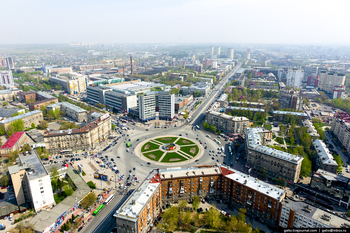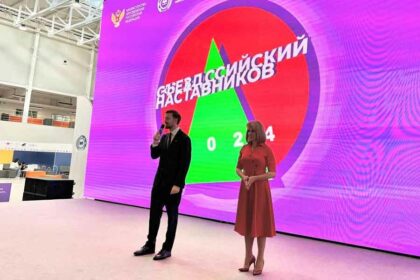Reading. Part 1. Headings for Paragraphs. You are going to read an article about Siberia. Choose the most suitable heading from the list A-H for each paragraph (1-8). There is one extra heading you do not need to use. There is an example at the beginning (0).

0 Pleasant Summers
A Siberian Climate
B Trans-Siberian Railway
C Geographical Position
D The Rise of Civilization
E Natural Resources
F A Place of Exile
G The West Siberian Plain
H Forests
(1) Siberia is a vast region in Russia, situated mostly in the country\’s Asiatic part. On the West, it is bordered by the Ural mountains; it is washed by the Arctic Ocean on the North, and by the Pacific Ocean on the East; on the South, it is bordered by Mongolia and China.
(2) Three major geographical areas are traditionally distinguished in Siberia. They are the West Siberian Plain, the Central Southern Plateau, and the Russian Far East. The WSP is one of the largest plains in the world, with the area of about 3 million square kilometers. There are lots of forests, steppes, and some hills in this part of Siberia. Several major Asiatic rivers flow along the plain, too.
(3) The climate in Siberia is called sharply continental. The area is notorious for its long harsh winters, with the lowest temperatures in the world recorded there. Even in the South of Siberia, extremely low temperatures throughout January and February are not uncommon. In January 2001, the temperature in some regions dropped below -60C, and stayed there for several weeks.
(0) Summer is often very warm, especially in the South-West of Siberia. Hot spells are not rare. In July, the thermometer may climb to +45C. Many rivers, lakes, natural and man-made beaches make summers in Siberia very pleasant.
(4) Siberia is outstandingly rich in mineral resources, including coal, natural gas, petroleum, diamonds, and gold. In the twentieth century, many industries grew there. Plants and factories flourished, with all the usual pollution problems springing up almost everywhere.
(5) A large part of Siberia is covered with forests. Up North and in the East, the forests are called taiga. They consist chiefly of evergreen coniferous trees, which are common for many areas in the world, including Scandinavia, North America, and Russia. Forestry is an important industry in Siberia. The population of rural areas also goes in for hunting, nut and berry gathering.
(6) The Russian settlement of Siberia began in 1581 and continued intermittently until the end of the nineteenth century. The Trans-Siberian Railway, built in 1891-1905, finally connected Siberia to the main part of Russia.
(7) For centuries, Siberia was synonymous with the place of exile for common criminals, and political prisoners. After the December 1825 nobility uprising against the tzar, many rebels were sentenced to life imprisonment in remote Siberia. The wives followed their husbands voluntarily. Lots of them perished en route, or during the first harsh winters. A few managed to survive, helping turn their places of exile into centers of civilization.
Part 2. Multiple Choice.
You are going to read a text about Novosibirsk, the largest city in Siberia. For questions (8-14) choose the answer (A, B or C) which you think fits best according to the text.
8. Novosibirsk population is
A Close to one million
B The same as in Moscow
C Over one million
9. The Trans-Siberian Railway
A Didn\’t play a large role in the city\’s development
B Played a large role
C Was never finished
10. The city was called Novosibirsk
A Right after the revolution of 1917
B In honour of the first settlers
C In the 1920\’s
11. Novosibirsk is called the capital of Siberia because
A it is the industrial center
B it is the cultural center
C it is both the industrial and cultural center of Siberia
12. Inside the city, one can use
A many kinds of public transportation
B suburban trains only
C taxis only
13. The City Day is celebrated
A in spring
B in autumn
C annually
14. The Picture Gallery is best known for
A its collection of primitive art
B its exhibition of old icons
C the Rerichs\’ pictures
TEXT: Novosibirsk
Novosibirsk is the third largest city in Russia. Its population is 1,400,000. It is situated in the South-West of Siberia. If you want to find it on the map, you have to look at the crossing of the following borders: Kazakhstan, Mongolia and China. Novosibirsk is often called the Capital of Siberia; it is also the center of the Novosibirsk Oblast (region). The region\’s territory equals that of France. It is located on the Great Siberian Plain. There are no mountains or hills in the region, but the territory is rich in forests, rivers and lakes.
The city was founded in 1893, when the Trans-Siberian Railway was built. At first it was a small village called Gusevka. It kept growing together with the road. Many people came from various regions of Russia in search of new spaces, jobs, better life. In the beginning of the twentieth century, the first schools, shops, hospitals, the post-office appeared. The engineer and writer Nikolai Garin-Mikhailovsky is officially considered to be the founding father of the new city. He designed the first buildings and the bridge across the Ob River, which is the largest river in the Russian Asia, and spent a lot of time and energy on promoting the idea of a large city in Siberia. The new settlement received the city status and was named Novo-Nikolaevsk, in honour of the last Russian tsar, Nikolai Romanov.
After the revolution of 1917, the city continued to grow, and more and more people moved to the region. Though the winters sometimes are quite severe, with the temperatures dropping well below zero centigrade, the summers are very warm. In July, hot spells of three or four weeks are not uncommon. Fruits and vegetables can be grown, animals abound in the forests, there is plenty of fish in the rivers and lakes, people relax after the frosts.
In 1922, the city was renamed Novosibirsk, to signify the beginning of a new era in the country\’s history. It was developed as a major industrial and cultural center. Siberia ceased to be the dreaded place of exile and was gradually becoming a recognized part of the country where lots of people moved to of their own free will. During World War Two, many factories and plants were moved from the European part of Russia farther east. After the war ended, those industrial workplaces remained in Novosibirsk, thus bringing about a lot of new jobs and opportunities. The major industries today are machine-building, textile, chemical, metallurgical.
1945, the year of the Allied Victory over the fascist Germany, brought about another major change in the city\’s life. The new Opera and Ballet Theater was opened, and the first performance took place on May 9, 1945. The tall spectacular building with its domed roof quickly became the city\’s most important landmark. There is a large square in front of it, and many citizens like to stroll around the square along the shaded alleys, or sit on numerous benches enjoying the sun in summer. The theater quickly became the most popular cultural center in the city, and then in the whole of Siberia. It seats 3,000 spectators. Many classical and modern operas and ballets are performed there, as well as symphony concerts and children\’s shows. The ballet troupe is one of the best in the country, and it often travels around the world with a full programme of ballets and concerts.
Among the chief attractions of the city and town are various museums, including the Geology Museum with its collection of precious stones and gems. There is a good picture gallery with a permanent exhibition of the artworks by Nikolai and Stanislaus Rerich, as well as several exhibitions which are renewed and changed regularly. The vast city Zoo receives many visitors through the summer. Adults and children alike enjoy meeting various exotic animals, and playing among the dinosaur replicas. The City Day is celebrated every year, with lots of festivities everywhere.
The city was built on the two banks of the Ob River, and in 1957, an artificial lake was built near Akademgorodok. It is hard to imagine that in Siberian summer, the city-dwellers rush to the beaches to swim in the river and the Ob Sea, as it is called, and to sun themselves. Lots of people go mushroom-hunting and work in their vegetable gardens, where lots of fruits, vegetables and berries are grown.
Various kinds of transport are used in all of Novosibirsk. If you wish to get to the city center from Akademgorodok, you should take a bus or a minibus. Inside the city, there are buses, trolley-buses and streetcars. In 1980\’s, the first subway stations appeared. They eased the pressure on the city traffic considerably. Naturally, one can hire a taxi or go anywhere by car.
Part 3. Gap Fill
You are going to read a text about a town in Siberia, Russia. Several words have been removed from the text. Read the text, and choose the words from the list below. There are five words which you do not need to use. Use each word only once. Change the form of the word where necessary.
Akademgorodok was (1) ….. in 1957. It is officially called the Siberian Branch of the Russian Academy of Science. This academic community is situated about thirty kilometers from the (2)…. center, but it is considered to be part of Novosibirsk. It is well-planned, the architects even received (3) … state award for their work. When you come into the town, first you see what\’s called the Builders District. It was decided that the very first blocks of (4) …. should be given to those who build the town, and it was a good (5)…… Then you go on along several streets where most of the research institutes are (6)….. At the beginning of Morskoy prospect, which is the (7)…… street in town, you see the Presidium building. The people who live in Akademgorodok have a (8)….. of imagination, and they loved building this new town. They gave all the streets and places unusual and colorful names. \”Morskoy\” means \”Sea\”, the street goes all across town straight to the beach and (9)…. Ob Sea, an artificial water reservoir. There are exotic names like The Golden Valley Street, which got its name (10)…. autumn, or Pearly Street, which branches off Morskoy Prospect.
Novosibirsk State University (11)…. also located in Akademgorodok. There are several museums, an English-speaking school, the House of Scientists, where various meetings and conferences are held, and the Botanical Garden. When building this town, the architects counted (12)…… single tree and tried to preserve as much of the natural environment (13)…. possible. For example, the English school, (14)….. occupies 1,500 square meters, was built on a clearing in the woods. Not a single tree was cut down, and all the trees that now stand around the school grounds are the original forest plants.
Most visitors are charmed by the town\’s originality of design and (15)…. unique natural environment.
Words: find, decide, city, at, the, flat, which, many, situation, that, a, its, in, their, every, main, as, lots, be, found
Part 4. Writing
Read the following letter. Find the five hidden questions which require answers, in addition to several direct questions asked in the letter. Then write your own reply to this letter. The reply should not be longer than 200 words.
Dear Friend,
We have finally obtained our visas, now is the time to plan! We\’ll book the tickets next week, and start packing. Since we\’re coming in winter, we\’d appreciate your advice on some of the points. Do we take the warmest clothes and shoes? Is it necessary to bring our own skis, or can we rent them? How do we get to your place from the airport? We think that $100 is enough for two weeks. We are sure that there will be time to visit some places of interest, too.
Please do not hesitate to tell us if you want us to bring something special for you and your family.
Yours, ….
Part 5. Grammar.
Change the following sentences so that their meaning remains the same. The first sentence has been done for you (0).
(0) Everybody knows that earthquakes cannot happen in Siberia.
Can\’t: Earthquakes can\’t happen in Siberia.
1. On Saturday, September 27, there was a sudden tremor in many regions of Siberia.
Felt:
2. Most people didn\’t know what it was.
Understand:
3. Seats and chandeliers shook in a theater, furniture moved in homes.
Began:
4. Spectators were evacuated from public places.
Had to:
5. Later, a warning was issued over the radio, and people went outside.
The authorities:
6. One had to take one\’s documents and put on warm clothes.
Must:
7. News began to pour in much later.
Broadcast:
8. Some cracks appeared in older buildings.
Developed:
9. No serious damage was done.
Damaged:
10. Many people still feel scared.
Afraid:
KEYS
Part 1. Headings. Score: 8 points
Key:
A (3) Siberian Climate
B (6) Trans-Siberian Railway
C (1) Geographical Position
E (4) Natural Resources
F (7) A Place of Exile
G (2) The West Siberian Plain
H (5) Forests
D (8) The Rise of Civilization is an extra which you do not need to use.
Part 2. Multiple Choice. Score: 7 points
8 – C, 9 – B, 10 – C, 11 – C, 12 – A, 13 – C, 14 – C.
Part 3. Gap Fill. Score: 15 points
Words: 1 – founded; 2 – city; 3 – a; 4 – flats; 5 – decision; 6 – situated; 7 – main; 8 – lot; 9 – the; 10 – in; 11 – is; 12 – every; 13 – as; 14 – which; 15 – its
Words you do not need to use: find; many; their; that; at
Part 4. Writing a Letter. Score: 25 points ( 5 points for \”hidden questions\”, 20 points for the letter itself).
The five hidden questions suggested here are:
1. Do we need any other documents, besides the visas?
2. Are there any things we should not pack?
3. Are ski shoes rented together with the skis?
4. How much money does one need for two weeks?
5. Are there any places of interest?
Tips:
If your students come up with some other \”hidden questions\”, let them.
Be sure to tell them that the original letter contains 114 words, so that they should compose a letter which is about twice the length of this one. Any mistake (spelling, grammar) is counted as a minus point.
Part 5. Grammar. Score: 10 points.
KEY (suggested sentences):
Felt: A sudden tremor was felt on Saturday, September 27.
Understand: Most people couldn\’t understand what it was.
Began: Seats and chandeliers began to shake in theaters.
Had to: Spectators had to be evacuated.
The authorities: The authorities issued a warning.
Must: Documents must be taken.
Broadcast: News were broadcast much later.
Developed: Older buildings developed some cracks.
Damaged: Nothing was seriously damaged.
Afraid: Many people are still afraid.
Total score: 65 points.
Нина Коптюг, кандидат филологических наук, учитель английского языка, Новосибирск











 Выбор читателей
Выбор читателей


Комментарии